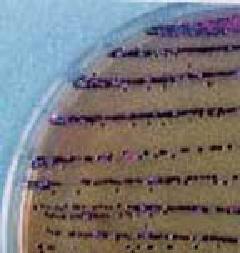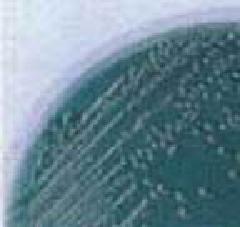- Yokohama-shi Top Page
- Health, Medical Care and Welfare
- Health and Medical Care
- Food safety
- Food Sanitation Laboratory
- Bacterial testing
- Food poisoning bacteria test
Here's the text.
Food poisoning bacteria test
Last update date April 2, 2024
What is food poisoning?
Food poisoning is "sanitary harm caused by ingesting microorganisms, chemical substances, natural poisons, etc. contained in foods, additives, containers and packaging, etc."
The number of food poisoning cases varies from year to year, but since 2008, the number of cases has been around 1,000 per year, and the number of patients has been around 20,000. And more than 80% of the etiological agents are caused by bacteria and viruses.
Here are some of the food poisoning caused by bacteria.
Bacterial food poisoning.
It can be divided into three parts.
Infected food poisoning
It is food poisoning caused by the attached bacteria themselves.
Salmonella

Salmonella on a DHL agar medium
Salmonella is widely distributed in all mammals, birds, reptiles, and amphibians, and perhaps it is not rare to be separated from the natural environment, such as soil and river water by contamination. It also resist drying well and survives for several years in soil and frozen foods. The causative food is mainly eggs and meat.
Inspection methods
In order to increase the activity of low-activity bacteria, it is pre-sterilized using BPW, then sterilized with RV medium and TT medium, separated with a DHL agar medium or chromoagar salmonella medium medium, etc., and confirmed by property test.
Vibrio parahaemote

Vibrio parahaemolyticus on TCBS agar medium
Since this bacterium is resident in seawater and sea mud, it is suitable for growth in an environment with a salt concentration of about 3 to 7%, but it is vulnerable to fresh water and cannot grow with tap water. It is also vulnerable to heat and kills it for about 10 minutes at 60 ° C for about 10 minutes.
The epidemic of food poisoning becomes summer, as Vibrio parahaemote begins to grow as seawater temperatures rise, but food poisoning may occur throughout the year due to the increase in imported ingredients.
The main causative food is marine seafood, but there are many cases of food poisoning caused by secondary contaminated foods through cutting boards, towels, fingers, etc. When shallow pickles of vegetables are secondarily contaminated, bacteria grow with moderate salt and cause food poisoning.
Precautionary methods are to wash seafood well with tap water before cooking, and to distinguish cutting boards exclusively for fish. Also, keep it below 10 ° C and eat raw foods as soon as possible.
Inspection methods
There are MPN methods and qualitative tests. It is sterilized with alkaline peptton water, separated in chromoagabibrio or TCBS agar medium, and a property test is performed to confirm.
Campylobacter
It lives in the intestinal tract of all animals, including livestock, poultry, and pets. For this reason, meat and its processed products are often caused, and it is transmitted from water contaminated with human waste from wildlife and livestock. It survives for a long time even at low temperatures, and unlike other bacteria, causes food poisoning even in small quantities. In recent years, many food poisoning has occurred due to chicken sashimi and undercooked yakitori.
Handle meat cleanly, and heat the center at 75 ° C for at least 1 minute before eating.
Erotic Monas
Many inhabit freshwater (0-3% salt concentration), and when fish are infected, they die in large quantities when fish are infected. It is recognized as a bacterium causing diarrhea in humans and as a bacterium that infects fat, muscle tissue and organs.
The source of infection is due to water systems (river water, coastal seawater, mud and soil), which is widely distributed in the natural environment, and is widely detected in foods such as seafood and vegetables.
Preciiomonas sigeroides
It inhabits freshwater and is widely found in water and mud in rivers, ponds and lakes, and is often detected in water when the water temperature rises in summer. There were few outbreaks in Japan, and the main cause was insufficient heating of water and seafood.
Nugbibrio
This bacterium lives in brackish waters such as near the estuary where seawater and freshwater mixture, and after incubation period of 6 to 72 hours after incubation period, watery diarrhea・ It presents acute gastroenteritis symptoms such as vomiting, abdominal pain, and fever. It may also have cholera-like symptoms.
Vibrio Mimi Cas
It is distributed in freshwater and seawater because it is very similar in properties to Nagbibrio, and can grow at a salt concentration of 6% or less. Symptoms caused by this bacterium are similar to Nagbibrio.
Vibrio fluvilis
It is often separated from seawater in coastal and brackish waters and seafood that inhabits it. The ecology is similar to Vibrio parahaemolyticus, so the causative food and the route of infection are considered to be the same.
For inquiries to this page
Medical Care Bureau Health and Safety Department Central Wholesale Market Home Food Sanitation Laboratory
Phone: 045-441-1153
Phone: 045-441-1153
Fax: 045-441-8009
Email address: ir-honjo@city.yokohama.jp
Page ID: 224-824-110







